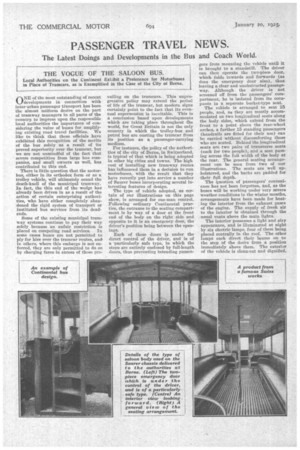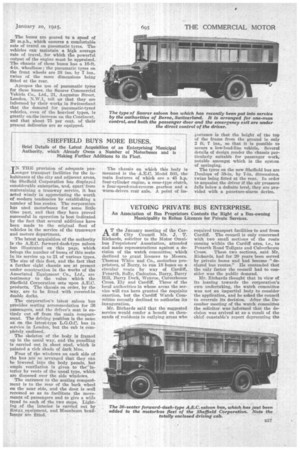PASSENGER TRAVEL NEWS.
Page 20

Page 21

If you've noticed an error in this article please click here to report it so we can fix it.
The Latest Doings and Developments in the Bus and Coach World.
THE VOGUE OF THE SALOON BUS.
Local Authorities on the Continent Exhibit a Preference for Motorbuses in Place of Tramcars, as is Exemplified in the Case of the City of Berne.
ONE of the most outstanding of recent developments in connection with inter-urban passenger transport has been the almost uniform desire on the part of tramway managers in all parts of the country, to impress upon the responsible local authorities the importance of considering the value of buses for amplifying existing road travel facilities. We like to think that these officials have exhibited this recognition of the merits of the bus solely as a result of its proved superiority over the tramcar, but we are not unmindful of the fact that severe competition from large bus companies, and small owners as well, has contributed to this end.
There is little question that the motorbus, either in its orthodox form or as a trolley vehicle, will ultimately sound the death-knell of the municipal tramway. In fact, the thin end of the wedge has already been driven in as a result of the action of certain enterprising authorities, who have either completely abandoned the rigid system of transport or instituted bus services from its deadends.
Some of the existing municipal tramway systems continue to pay their way solely because an unfair restriction is placed on competing road services. In some cases buses are not permitted to ply for hire over the tramcar routes, and in others, where this embargo is not enforced, they are only permitted to do so by charging fares in excess of those pre
veiling on the tramcars. This unprogressive policy may extend the period of life of the tramcar, but modern signs certainly point to the fact that its eventual supersession is inevitable. This is
a conclusion based upon developments which are taking place throughout the world, for Great Britain is not the only country in which the trolley-bus and petrol bus are ousting the tramcar from • it position as a passenger-carrying medium.
For instance, the policy of the authorities of the city of Berne, in Switzerland, is typical of that which is being adopted in other big cities and towns. The high cost of installing new tramway routes has influenced them in a decision to run motorbuses, with the result that they have recently put into service a number of Saurer buses incorporating several interesting features of design. The type of vehicle adopted, as certain of our illustrations on this page
show, Is arranged for one-man control. Following ordinary Continental practice, the entrance to the seating compart
meat is by way of a door at the front end of the body on the right side and opposite to it is an emergency door, the driver's position being between the openings.
Each of these doors is under the direct control of the driver, and is of a particularly safe type, in which the steps are entirely enclosed by full-length doors, thus preventing intending passen
gers from mounting the vehicle until it is brought to a standstill. The driver can then operate the two-piece door, which folds inwards and forwards (as does the emergency door also), thus leaving a clear and unobstructed passageway. Although the driver is not screened off from the passengers' compartment, he is isolated from its occupants in a separate bucket-type seat. The vehicle is arranged to seat 25 people, and, as they are mostly accommodated on two longitudinal seats along the body sides, which extend from the front to a point above the rear-wheel arches, a further 15 standing passengers (handrails are fitted for their use) can be carried without discomforting those who are seated. Behind the longitudinal seats are two pairs of transverse seats (each for two people), and a seat passing across the full width of the body at the rear. The general seating arrangement can be seen from two of our illustrations. The seats are well upholstered, and the backs are padded for their full depth.
The question of passengers' convenience has not been forgotten, and, as the buses will be working under very severe weather conditions in the winter months, arrangements have been made for heating the interior from the exhaust gases of the engine. The supply of fresh air to the interior is obtained through the usual vents above the main lights.
The interior possesses a light and airy appearance, and is illuminated at night by six electric lamps, four, of them being placed centrally in the roof. The other lamps each direct their beams on to the step of the &Ors from a position immediately above them. The exterior of the vehicle is clean-cut and dignified. The buses are geared to a speed of 20 m.p.h., which ensures a comfortable rate of travel on pneumatic tyres. The vehicles can maintain a high average rate of travel, for which the powerful output of the engine must be appraised. The chassis of these buses has a 16-ft. 4-in. wheelbase ; the pneumatic tyres on the front wheels are 38 ins. by 7 ins., twins of the same dimensions being fitted at the rear.
Apropos the use of pneumatic tyres for these buses, the Sourer Commercial Vehicle Co., Ltd., 21, Augustus Street, London, N.W.1, tell us that they are informed by their works in Switzerland that the demand for pneumatic-tyred vehicles, even of the heaviest types, is greatly on.the increase on the Continent, and that about 75 per cent, of their present deliveries are so equipped.






























